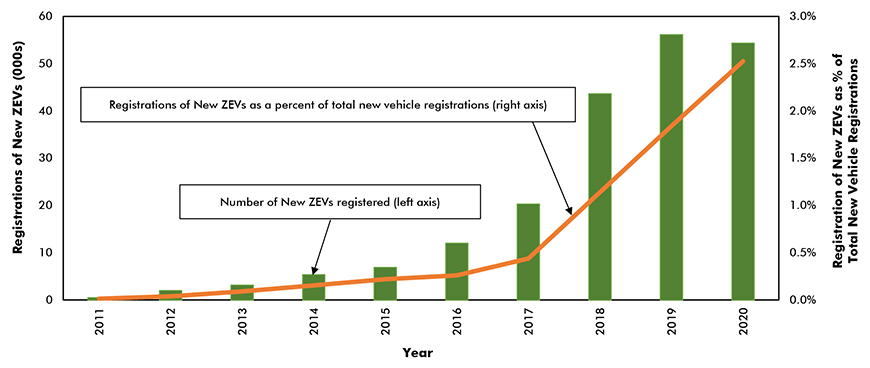After posting double-digit percentage gains for the past eight consecutive years, sales of zero-emission vehicles (ZEVs) in Canada stalled in 2020 due to the impact of COVID-19 lockdowns. However, the decline in ZEV sales of -3.2% (from 56K to 54K) was relatively mild compared to the -25.7% drop in total vehicle sales excluding ZEVs. As a result, the share of total Canadian vehicle sales that were ZEVs increased from 2.9% in 2019 to 3.5% in 2020.
Global EV sales did not get COVID in 2020
So how do Canadian ZEV sales compare to other countries? In 2020, global sales of electric vehicles, made up of battery electric (BEVs) and plug-in hybrid electric vehicles (PHEVs), increased by +43% to 3.2 million units. This gain was driven by a +137% rise in European sales, followed by a +12% rise in Chinese sales and a +4% increase in U.S. sales. In Japan, sales of ZEVs declined by -28%.
The combination of a +43% y/y increase in electric vehicle purchases and a -17% drop in sales of vehicles with conventional internal combustion engines (ICEs) caused the global share of ZEV sales to increase from 2.5% in 2019 to a record high of 4.2% in 2020. Factors contributing to the surge in European sales included a variety of existing policy supports that were augmented by additional stimulus measures.
Almost all Canadian EV sales are in three provinces
From a regional perspective, as they have for the past eight years, over 95% of ZEV sales in Canada occurred in just three provinces. Although it is home to just 22% of Canadians, Quebec accounted for almost half of the country’s ZEV sales. After more than doubling in 2019, sales of ZEVs in British Columbia retreated by -10.4% in 2020. However, despite this pullback, sales in the Pacific Province accounted for 28% of the national total.
Following a -40% drop in 2019, sales of ZEVs in Ontario rose from 9,800 to 10,500 (+7.7%) in 2020. However, despite this modest gain, the province with almost 40% of the country’s population accounted for only 20% of total national electric vehicle sales.
Demand for EVs should strengthen in 2021 and 2022
After collapsing due to COVID-19 in the first half, sales of ZEVs briefly rebounded in the second half of 2020 fuelled in part by ultra-low interest rates and a solid recovery of employment. While the second wave of COVID-19 dampened sales late in 2020, they recovered early in 2021.
Going forward, stronger jobs growth, a vaccine-induced increase in consumer confidence, plus the incentives offered by the federal government, British Columbia, Nova Scotia, Quebec, and the Yukon territory will boost demand.
Also, the network of charging stations, which now total 6,160 across the country, increased by 22% over the past twelve months. This will partially allay EV drivers’ fears of falling off the charging network.
Nevertheless, according to a recent KPMG survey, several factors are preventing potential buyers from choosing a ZEV. These include their relatively high cost, their limited (especially in the winter) driving range, the lack of a nationwide charging network and the potential cost to replace a vehicle’s battery. Prices (before incentives) for the 17 brands of ZEVs in Canada range from a luxury-end high of $120,000 to a not so low $39,000 and average in the range of $40,000 to $50,000.
Scarcity of essential minerals may hobble EV production in the medium term
While, in the near term, demand for EVs appears quite strong, the same cannot be said for their supply. The global shortage of semiconductor chips has contributed to a significant slowdown in the manufacture of electronics and motor vehicles. Electric vehicles affected include Tesla, Ford, Mercedes Benz, and Nissan. Moreover, it is uncertain how long the chip shortage will dampen vehicle production.
Regarding the longer-term outlook for EV supply, a recent newsletter produced by the International Energy Agency highlighted that electric vehicles use six times the mineral inputs of a conventional vehicle. Moreover, several of the key minerals used in ZEVs are available only from a small number of countries, some of which are likely to be unreliable suppliers.
While forecasts of future electric vehicle demand are highly speculative there is evidence that a ‘heating up’ has already contributed to higher prices for EV essential minerals. For example, over the past six months, the price of lithium (the major element in an EV battery) has increased from $7,616 Cdn/ton to $16,900 Cdn/ton. Also, over the past year, the price of copper has doubled and according to Trading Economics, it is expected to remain high since it is a key component in electric vehicles, in windfarms and in the expanding electricity grid.
While motor vehicle net zero carbon emissions by 2050 is a theoretical possibility, the shortcomings of the EVs currently available (i.e., high cost, a limited charging network and the Canadian climate) indicate that several high hurdles stand in the way of achieving such a goal.
John Clinkard has over 35 years’ experience as an economist in international, national and regional research and analysis with leading financial institutions and media outlets in Canada.
Canada – Registrations of New Zero Emission Vehicles (ZEVs) – Total and % share of all vehicles

Chart: ConstructConnect — CanaData.
Please click on the following link to download the PDF version of this article:
Economic Snapshot Vol. 19, Issue 10 – Electric vehicles: there are more on the road, but bumps ahead – PDF










Recent Comments